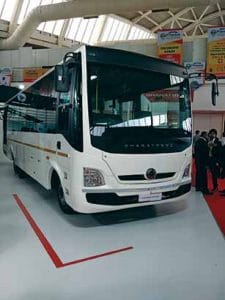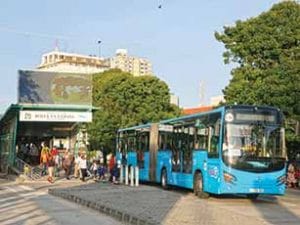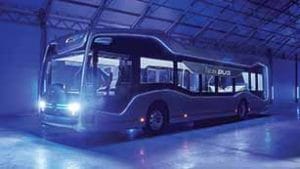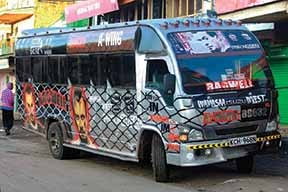Digitising public transport has become of paramount importance amid the Covid-19 environment.
Story By Deven Lad
The speed of digitisation of public transport is made even more important by Covid-19. It is undoubtedly driven by the need to protect people involved in running the public transport as well as the people using it for travel against the virus. Highlighting this very issue, M Ramachandran, Former Secretary, Ministry of Urban Development, Government of India, stressed on the opportunity to increase efficiency and lower the cost of operations. Stating that there was a need to provide passengers with a new experience, he mentioned that digitisation of public transport has been boosted by the introduction of FASTag. “Nearly 450 toll plaza have dedicated FASTag lanes, and over 17 million prospects have been issued last month,” he added. Drawing attention to the 17 million prospects having carried out four billion transactions amounting to Rs.65 crores per day, bringing the logistics cost down in the process, Ramachandran expressed that 22 per cent of the national highways with a length of over 150,000 kilometres carry roughly 40 per cent of the traffic, making them a primary mode of transportation in India.
Speaking at a webinar organised by the Busworld Academy in partnership with UNCRD Japan and UN-Habitat on digitisation of public transport, he averred that the National Highways Authority of India(NHAI) should leverage digitisation to increase the pace of its projects and to better monitor them by using IoT. He stated that the NHAI should use monitoring devices like drones, radar, vehicle network surveillance, GPS devices among others while highlighting the organisation’s feat to be the first fully digital transactions agency. Drawing attention to how digitisation of public transport would support the sustainable development of society, Ramachandran explained that Intelligent Transport Systems (ITS) are capable of playing a key role in digitisation of urban mobility public transport mediums. He drew attention to location information and communication technologies that could make travelling safe, energy-efficient, seamless and comfortable. Highlighting the need to offer passengers with an Estimated Time of Arrival (EST) to attract more passengers and increase the overall efficiency of the operation, Ramachandran said that ITS, which led to the provision of 18000 modern buses in 170 cities in India, could be utilised for the same.
Enhancing public transport standards
Stressing on tracking surveillance, intelligent information system, global positioning system (GPS), synchronisation and an internet ticketing system, Ramachandran stated that an effective and sustainable transport system was the need of the hour. “Each project proposal or transport system should be linked to the measurable improvement in the service level benchmark,” he added. Of the firm opinion that digitisation will bring opportunities for the public transport sector in the form of quality, efficiency and lower operational costs, Ramachandran averred that it will also open up new revenue streams and ensure a superior experience to the customers. Citing the need to employ new mobility concepts and technologies like driverless vehicles, he said that a lot more is needed to be done by the country’s state transport undertakings, by private bus operators and city administrations. Sharing information about his company’s work on four fronts, Connectivity, Autonomous, Shared Services and Electric (CASE), Karl-Alexander Seidel, CEO and Head of Daimler Buses India, mentioned that they are offering Busconnect system as standard on their BSVI buses.
Highlighting the benefits of the Busconnect system like fleet management, passenger management, reports, fleet tracking alerts and the ability for passengers to select the route they want to travel, Seidel informed that they are working on bringing the best and the latest technology and practices to India that they have developed in Germany. Pointing at other Busconnect functions like geofencing and entertainment, and how it could enhance customer experience for bus operators, he informed that various angles to aid further mobility development in the public transport space in India were being looked at. Pointing at electric vehicles, Seidel said that his company was closely following the developments in the area of charging infrastructure, development costs and components localisation. “We are looking at everything as a general project management practice when it comes to public transport in cities and how to enable cities to build a robust infrastructure,” he added.
Making public transport attractive through digitisation
Hinting at Daimler’s ability to enter the electric public transport space as soon as it identifies an opportunity and feels that the market is on the verge of exploding, Seidel expressed the need to integrate ITS systems seamlessly to ensure better efficiency and enhance passenger safety and convenience. “ITS systems currently exist as standalone systems,” he said. Highlighting the need to have technologies that ensure seamless integration such that the passengers benefit, the operators benefit, and the stakeholders also benefit, Seidel explained that it was also necessary to look at environment protection and energy conservation. “Connectivity and automation in the case of public transport and involving buses should also lead to a sustainable environment,” he quipped. Stressing on ‘Avoid-Shift-Improve’ framework, Stefanie Holzwarth, Urban Mobility, Urban Basic Services Section, Urban Practices Branch, UN-Habitat, averred that digitalisation of public transport should be achieved such that it elevates convenience and safety.
Of the opinion that the digitisation exercise should make public transport more attractive to passengers, Holzwarth stated that the UN-Habitat is focusing on reducing the need for motorised travel through transport demand management and by promoting urban public transport in its most efficient form possible. Drawing attention to electric mobility, she added, “Digitisation can have a revolutionary impact on public transport.” Giving the example of Dar es Salaam, Tanzania, where the public transport was transformed into a modern and successful Bus Rapid Transit (BRT) systems, Holzwarth stated that UN-Habitat has been identifying high demand commuter mass transit routes and corridors and finding ways to up their efficiency and sustainably with the commuter at the core. She also pointed at the centred public transport planning authority of Nairobi in terms of para-transit mapping and a BRT plan (Matatu routes).
Digitisation for safe and convenient public transport
Informing about UN-Habitat’s work in the area of understanding as well as helping transform public transport systems, Holzwarth drew attention to how smart bicycles in Hyderabad were offering first and last-mile connectivity to metro commuters. Highlighting its digital nature, she said that the main objective of digitisation should be to achieve a safe and convenient public transport that encourages private vehicle users to leave their vehicle behind. Stressing on apps. as facilitators of digitisation of public transport, Holzwarth mentioned that efforts should be made to leverage emerging technologies and gadgets like smart watches, smart glasses, etc., to make public transport and activities related to its use not only convenient but attractive to commuters. Hinting at a need for public transport bodies to partner with their passengers through digital tech platforms to enable a personalised experience with the means of need-based navigation (customer-oriented services), just in time services, etc., Holzwarth highlighted the drastic change in the Covid-19 environment where physical tickets are becoming redundant.
Emphasising on developments such as contactless services and electronic ticketing, she remarked that integrated public services and integrated ticketing will no longer be an option. Of the opinion that this would reduce travel time, boarding and unboarding time, enhance reliability, and encourage private vehicle owners to take to public transport, Holzwarth said, “Digitisation efforts do not leave out particular society groups such as the elderly and poor.” Pointing at changing governance, costs, and new staff profiles, could pose a threat to traditional operators, she advocated the avoidance of stand-alone sectoral solutions. Of the opinion that different digital modes should be promoted — like ‘one-stop-shop’ platform or MaaS, Holzwarth said support should be given to homegrown local solutions and local startups. “Emphasis should be on facilitating multi-stakeholder partnerships where the government can encourage open access to data collected by companies and public entities,” she added.
In favour of promoting interoperability through the development of technical standards for communication and devices, through the development of municipal capacities in view of collecting, maintaining and analysing data as well as managing integrated transport systems and infrastructure, Holzworth stressed on the need to protect the environment. Alok Sethi, General Manager, Transportation Technology Solution (DIMTS), expressed that the implementation of ITS in Delhi’s public bus transport system has changed the face of it. He informed that his company conceptualised the scheme by including private stage carriage buses as well. “Under this scheme, 657 bus routes of Delhi were grouped into 17 clusters. Each cluster serviced by both, Delhi Transport Corporation and a private operator,” he added.
Providing an overview of the current situation in Delhi where the ITS-backed public transport service comprising buses is referred to as a cluster bus or orange bus service, Sethi, explained that there is an incentive based scheme attached. It measures against performance benchmarks, he revealed. Highlighting how ITS has helped Mysore’s public transport to increase ridership by 15 per cent, Sethi stated that GPS based automatic vehicle location system has been deployed. “The system monitors the entire fleet,” he added. Stressing on leveraging ITS in public transport such that it acts as a guiding arm, Sethi said that there is a need to train personnels like managers, drivers, conductors, schedulers, route designers, etc. to understand how it worked and how they could leverage it to their advantage. Urging public transport personnels to divide the use of ITS into sections such as planning, design, implementation and evaluation, Sethi revealed that they would soon release a manual. The manual would help public transport organisations to ramp up as well as increase their efficiency
Drawing attention to how innovative use of ITS can help digitise, implement new systems such as electronic ticketing and contactless travel, Dr. Kulwant Sigh, Advisor, Busworld Academy, expressed that real-time tracking of bus, of passenger occupancy information, of EST are some of the features that will define the public transport of the future. A future that would not be devoid of unprecedented challenges, he concluded.
































